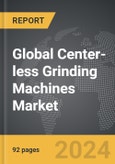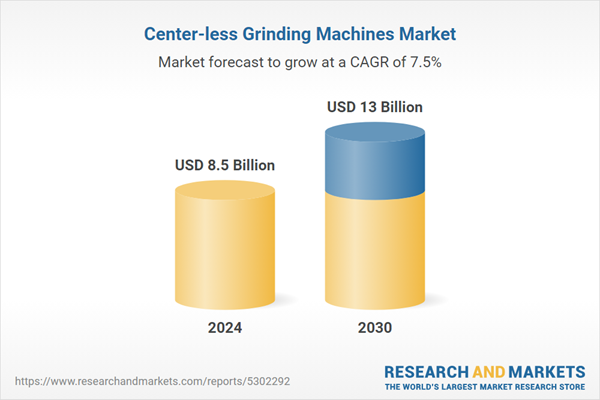Global Center-less Grinding Machines Market - Key Trends and Drivers Summarized
Why Are Center-less Grinding Machines Essential in Modern Manufacturing?
Center-less grinding machines are indispensable tools in the realm of precision manufacturing, particularly for producing high-quality cylindrical components with exceptional accuracy and surface finish. Unlike traditional grinding methods that rely on holding the workpiece in place using a spindle or fixture, center-less grinding utilizes a supportive configuration where the workpiece is placed between a rotating grinding wheel and a regulating wheel. This setup not only allows for continuous feed-through processing but also eliminates the need for complex work-holding fixtures, resulting in reduced cycle times and higher throughput. Center-less grinding machines excel in producing components with very tight tolerances, making them ideal for high-precision parts in industries such as automotive, aerospace, medical devices, and electronics. From producing precision shafts and bushings to grinding small-diameter materials like needles and pins, these machines are capable of handling a diverse range of materials, including metals, ceramics, and polymers. Additionally, center-less grinding ensures superior roundness and concentricity, which are crucial for the functionality and durability of many mechanical parts. Their capability to perform both through-feed and in-feed grinding further enhances their versatility, enabling manufacturers to achieve complex geometries and fine surface finishes in a single operation.How Are Technological Advancements Revolutionizing Center-less Grinding Machines?
The evolution of center-less grinding machines has been significantly influenced by advancements in technology, leading to enhanced precision, automation, and efficiency. One of the most notable developments is the integration of CNC (Computer Numerical Control) technology, which has transformed conventional grinding machines into smart, automated systems capable of delivering highly precise and repeatable results. CNC-controlled center-less grinders allow for the programming of complex grinding parameters, including feed rate, wheel speeds, and positioning, resulting in improved process stability and reduced human error. This level of automation also facilitates the grinding of complex shapes and profiles, expanding the range of components that can be manufactured using center-less grinding. Another significant technological advancement is the adoption of high-speed spindles and advanced grinding wheel materials, such as cubic boron nitride (CBN) and diamond abrasives. These materials enable faster material removal rates and longer wheel life, making the grinding process more efficient and cost-effective. Additionally, the use of adaptive control systems and real-time monitoring technologies allows operators to detect and respond to variations in grinding conditions instantly, ensuring optimal process performance and reducing the likelihood of defects. The implementation of Industry 4.0 concepts, including IoT (Internet of Things) connectivity and data analytics, is also gaining traction, providing manufacturers with valuable insights into machine performance, maintenance needs, and overall equipment effectiveness (OEE).What Are the Key Challenges and Market Dynamics Impacting the Center-less Grinding Machine Industry?
The center-less grinding machine industry, while experiencing steady growth, faces several key challenges that influence its market dynamics and operational strategies. One of the primary challenges is the high initial cost associated with these machines, especially for advanced models equipped with CNC and automation features. This significant capital investment can be a barrier for small and medium-sized manufacturers, limiting the widespread adoption of cutting-edge grinding technologies. Additionally, the complexity of setting up and operating center-less grinders requires skilled technicians and operators who are proficient in aligning the wheels, adjusting feed rates, and managing thermal influences on the workpiece. The industry is also grappling with a shortage of skilled labor, as experienced operators are becoming increasingly scarce, particularly in mature markets like North America and Europe. This talent gap is prompting manufacturers to invest in training programs and user-friendly machine interfaces to simplify operations and reduce the dependency on specialized skills. Another key challenge is the need to maintain tight tolerances and surface finishes in high-volume production environments, where even minor variations can lead to significant quality issues and rework costs. Environmental concerns also play a role, as grinding operations typically involve high energy consumption and generate waste, making it imperative for manufacturers to adopt greener practices and comply with environmental regulations. On the market side, global competition is intensifying, with Asian manufacturers, particularly from Japan and Taiwan, offering high-quality machines at competitive prices, putting pressure on established players in Europe and North America to innovate continuously. The industry is responding by focusing on product differentiation through the development of machines that offer greater flexibility, shorter setup times, and enhanced precision.What’s Driving the Growth of the Center-less Grinding Machine Market?
The growth in the center-less grinding machine market is driven by several factors that reflect broader trends in industrial manufacturing and evolving customer demands. One of the primary drivers is the rising demand for high-precision components in sectors such as automotive, aerospace, and medical devices. As these industries continue to push the boundaries of miniaturization and performance, the need for components with exceptionally tight tolerances and flawless surface finishes is growing, thereby fueling demand for center-less grinding machines that can deliver such levels of precision. Another significant driver is the increasing adoption of automation and Industry 4.0 practices in manufacturing. Automation solutions, such as robotic loading and unloading systems, are being integrated into center-less grinding setups to enhance productivity, reduce labor costs, and minimize the risk of operator errors. This trend is particularly pronounced in high-volume production environments, where automated grinding cells can operate around the clock with minimal human intervention. Additionally, the rapid growth of the electric vehicle (EV) industry is creating new opportunities for the center-less grinding market, as the production of EV components, such as transmission shafts and rotor shafts, requires precise grinding processes to ensure optimal performance and durability. The expansion of the medical device industry is also a key growth driver, with center-less grinding machines being used to manufacture critical components like needles, implants, and surgical instruments that require impeccable precision and finish. Further, advancements in abrasive materials and grinding wheel technology are enabling faster material removal rates and improved surface quality, making center-less grinding more efficient and cost-effective. Together, these factors are propelling the center-less grinding machine market forward, solidifying its role as a crucial technology for producing high-quality, precision-engineered components across a diverse range of industries.Report Scope
The report analyzes the Center-less Grinding Machines market, presented in terms of units. The analysis covers the key segments and geographic regions outlined below.Segments: Segment (Center-less Grinding Machines).
Geographic Regions/Countries: World; United States; Canada; Japan; China; Europe (France; Germany; Italy; United Kingdom; Spain; Russia; and Rest of Europe); Asia-Pacific (Australia; India; South Korea; and Rest of Asia-Pacific); Latin America (Argentina; Brazil; Mexico; and Rest of Latin America); Middle East (Iran; Israel; Saudi Arabia; United Arab Emirates; and Rest of Middle East); and Africa.
Regional Analysis
Gain insights into the U.S. market, valued at $2.2 Billion in 2024, and China, forecasted to grow at an impressive 10.9% CAGR to reach $3.1 Billion by 2030. Discover growth trends in other key regions, including Japan, Canada, Germany, and the Asia-Pacific.Why You Should Buy This Report:
- Detailed Market Analysis: Access a thorough analysis of the Global Center-less Grinding Machines Market, covering all major geographic regions and market segments.
- Competitive Insights: Get an overview of the competitive landscape, including the market presence of major players across different geographies.
- Future Trends and Drivers: Understand the key trends and drivers shaping the future of the Global Center-less Grinding Machines Market.
- Actionable Insights: Benefit from actionable insights that can help you identify new revenue opportunities and make strategic business decisions.
Key Questions Answered:
- How is the Global Center-less Grinding Machines Market expected to evolve by 2030?
- What are the main drivers and restraints affecting the market?
- Which market segments will grow the most over the forecast period?
- How will market shares for different regions and segments change by 2030?
- Who are the leading players in the market, and what are their prospects?
Report Features:
- Comprehensive Market Data: Independent analysis of annual sales and market forecasts in US$ Million from 2024 to 2030.
- In-Depth Regional Analysis: Detailed insights into key markets, including the U.S., China, Japan, Canada, Europe, Asia-Pacific, Latin America, Middle East, and Africa.
- Company Profiles: Coverage of players such as Acme Manufacturing, Fives Group, Glebar, Hanwha Machinery, Jainnher Machine and more.
- Complimentary Updates: Receive free report updates for one year to keep you informed of the latest market developments.
Some of the 36 companies featured in this Center-less Grinding Machines market report include:
- Acme Manufacturing
- Fives Group
- Glebar
- Hanwha Machinery
- Jainnher Machine
- Junker
- Kmt Precision Grinding
- Micron Machinery
- Paragon Machinery
- Royal Master
Tariff Impact Analysis: Key Insights for 2025
Global tariff negotiations across 180+ countries are reshaping supply chains, costs, and competitiveness. This report reflects the latest developments as of April 2025 and incorporates forward-looking insights into the market outlook.The analysts continuously track trade developments worldwide, drawing insights from leading global economists and over 200 industry and policy institutions, including think tanks, trade organizations, and national economic advisory bodies. This intelligence is integrated into forecasting models to provide timely, data-driven analysis of emerging risks and opportunities.
What’s Included in This Edition:
- Tariff-adjusted market forecasts by region and segment
- Analysis of cost and supply chain implications by sourcing and trade exposure
- Strategic insights into geographic shifts
Buyers receive a free July 2025 update with:
- Finalized tariff impacts and new trade agreement effects
- Updated projections reflecting global sourcing and cost shifts
- Expanded country-specific coverage across the industry
Table of Contents
Companies Mentioned (Partial List)
A selection of companies mentioned in this report includes, but is not limited to:
- Acme Manufacturing
- Fives Group
- Glebar
- Hanwha Machinery
- Jainnher Machine
- Junker
- Kmt Precision Grinding
- Micron Machinery
- Paragon Machinery
- Royal Master
Table Information
| Report Attribute | Details |
|---|---|
| No. of Pages | 92 |
| Published | April 2025 |
| Forecast Period | 2024 - 2030 |
| Estimated Market Value ( USD | $ 8.5 Billion |
| Forecasted Market Value ( USD | $ 13 Billion |
| Compound Annual Growth Rate | 7.5% |
| Regions Covered | Global |









